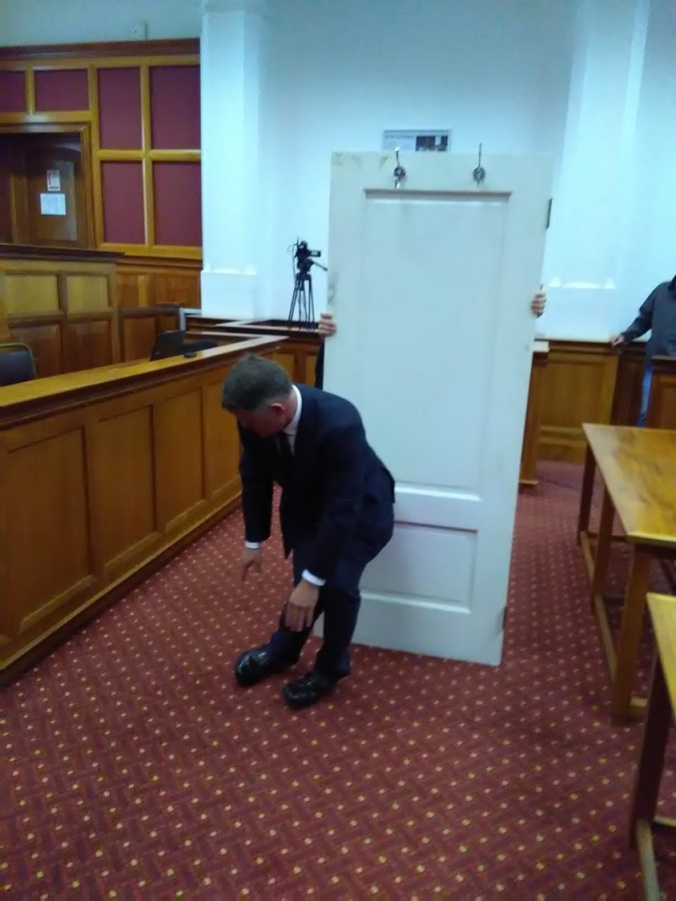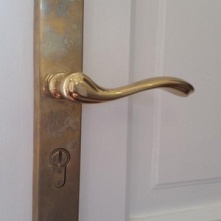
It’s unfortunate modern courts don’t make more use of schematics, multimedia and on-screen exhibits. One may argue that the handing out of paper printouts of exhibits, including blueprints of the crime scene, negate the need for overhead displays. Why does it matter if the media and public are in the dark about a crime scene, as long as the court can orient itself?
I’m not sure courts are that oriented. Putting a door inside a courtroom doesn’t do much to orient a court; if anything, it makes it all the more confusing because it’s taken completely out of context.
In the Oscar Pistorius case, a big misstep was in not taking Judge Masipa in loco to the crime scene, to get a feel for the dimensions and layout of the crime scene. The prosecution thought they were clever, and doing enough, by showing the inside of the toilet door, but what really mattered was where Oscar was when he fired the shots. If they’d had that as their exhibit the verdict may have turned out quite differently. I demonstrated this in a blog titled Modelling Reeva’s Fall behind the Door. What was happening in front of the door was critical to establishing what happened behind it.
In the Van Breda and Rohde cases, there were in loco inspections.
In loco becomes invaluable particularly where there is the possibility of obstruction of justice. When the accused imagines something a particular way, without a schematic in front of you, it’s all very much up in the air. It’s hypothetical. What was so frustrating in the Oscar case was something so basic as trying to remember on which side of the bed he was sleeping.
In the Rohde case we know he was on the side furthest from the front door and the bathroom.
A key way an accused obstructs justice is through their advantage of being far more aware of the potential practical scenarios in situ, and the theoretical ambiguity involved at a crime scene in which they hold the trump card. They know what’s possible, and the court doesn’t. They know what’s not possible, or likely, and here the court has a weakness because the court doesn’t know that either.
The easy way to test the version of an accused is by becoming as familiar as we can be with the crime scene, and then activating particular versions within a schematic to see exactly how they play out. As soon as we visualise the crime scene in more detail, obvious problems arise, and often, obvious solutions to a particular version.
With that in mind, let’s take a look at the layout of Suite 221 at the Spier Wine Estate.

In Jason Rohde’s version, two things happen. He’s on a bed, asleep, and then he’s at the bathroom door. Going through it step by step:
1. According to Rohde’s affidavit, he went to sleep at about 03:30. At about 07:00 both Susan and Jason woke up. Susan was still furious with him. Susan still looked very upset. Jason turned on his side and went back to sleep. It’s strange that Rohde has himself awake at 07:00, even though he does nothing. The showing of the message seems to be about a) confirming and time-stamping that Susan is alive [ Dr Akmal Coetzee-Khan believes time of death is 05:40], b) confirming that Susan is still worried about Jolene, and c) directing scrutiny towards the WhatsApp messages – basically asking onlookers to check Susan’s phone and see, ah, so she responded to Jolene’s message at 07:06…
It was supposedly at this time – 07:06 – that Susan sent the final WhatApp to Jolene. It would be interesting to check the computer logs to see if there is any activity. Rohde saying he was awake is an interesting volunteering of information.
2. When he woke up he couldn’t get into the bathroom door.
Rohde says he knew the door was locked from the inside, and he couldn’t open it. Interestingly, he doesn’t seem to notice his wife isn’t lying next to him when he woke up. He goes from waking up immediately to the bathroom door.
This is the part that doesn’t make much sense. Rohde can’t get into the door, so he phones his wife. It’s not clear whether he calls out her name. Did any witnesses hear him shouting Susan’s name at 08:00? He also leans in to see if he can hear the sounds of bathwater. Then he kicks the door. What does he not do? Well, why not go around and knock on the bathroom window, or see if he can see into the bathroom window? The bathroom window is immediately above the bath and opaque.

Not shown in the schematic here is what happens between 2 and 3, which is Rohde “calling for help” at 08:22. Even though he’s right at the door, he doesn’t go out the front door, or open it, to see if there are any cleaning staff walking outside. Since there’s a big conference, it’s likely that they would be moving around as late as 08:22. And what has he been doing for 22 minutes since waking up at 8? He doesn’t check the window. Instead he calls reception and speaks to Mavis, and only after calling reception does he try to kick down the door.
Now imagine the opposite scenario to what one would do if you thought someone was in the bathroom. Imagine Rohde chose the bathroom as his crime scene, what would he need to be aware of? Since the bathroom window was facing public walkways, it’s likely Rohde was very aware of the potential for passersby to see into the bathroom, especially if the lights were on inside. So he would close the shutters, and perhaps keep the lights off as far as possible. He’d also need to do the staging, if he was doing the staging, at a time when afterparty folks were mostly likely to be asleep. This makes 04:00 to 05:00 seem like a reasonable time of death – if Susan was murdered.
Rohde describes the door as solid and that it wouldn’t move an inch when he kicked it. Was it really that solid that if you intended kicking it open you wouldn’t be able to? Or was his heart not into it? Was it more important to have someone there witnessing him opening the door and dramatically “finding” Susan, and showing himself to be surprised and emotional?
In the Amanda Knox case there’s also the half-hearted effort to open the door with the body behind it, and the prime suspects also do just enough to leave a visible crack in the door to show they tried to open it.
When the police arrive, within moments they decide to kick open the door. It opens after one kick. Oscar Pistorius also has great difficulty opening his door, and must smash most of it to smithereens before he’s able to open it.
3. When the handyman arrives, according to Rohde he doesn’t allow the handyman to open the door. That’s why he’s there. Instead, Rohde opens the door and the handyman is standing on the front door side of the suite. Since toilet door open inwards, from the handyman’s vantage point as Rohde describes it, he can’t see into the bathroom even as Rohde opens the door. This allows Rohde to monopolise the reality of what is going on behind the door as he opens it – particularly the tightness of the knot and the number of loops around the door hook.
From the image below, it looks like the door hook isn’t anchored very well into the door. Notice the slight screw damage to the wood and paint.

4. At point 4, Rohde is on the other side of the door, immediately lifting Susan out of the hanging position, immediately contaminating and changing the crime scene. The handyman, Desmond Daniels is in the perfect position wedged half against the door and the door frame to sort of see Rohde “innocently” coming to the rescue of his wife, and also having his view of the hair iron cord partially obscured by the door. Almost the moment Daniels sees it, Rohde changes it.
As it happened, Daniels apparently saw more than Rohde gave him credit for.
And Daniels has testified that it was he who lifted Susan’s body from the door.
From iol.co.za:
On arrival, [Daniels] was let into room 221 by Jason. He said he asked Jason what the problem was and was told the door wouldn’t open [but nothing about his wife]. Daniels said he used a screwdriver to unlock the bathroom door. He said the door could also be locked and unlocked using a teaspoon, coin or similar object. He told the court there were teaspoons in room 221.
From the schematic we can see the area where the teaspoons were in the room was on a coffe table literally right opposite the bathroom door, bottom right in the image below.

Rohde let Daniels into the room but he also led him into the room. One question to ask is was the door open when Rohde urgently awaited Daniels? If it wasn’t open, why wasn’t it open?
“When I opened the door I saw a person lying down towards the basin. I opened the door about 30 centimetres ajar and saw the body from the knee down to the feet.
“The accused (referring to Jason) called ‘Suzy’.
“He went in and there was silence for about two to three seconds. He then called me to help. He said I should help him remove the cord from the neck,” said Daniels.
This is a huge giveaway. If it was a genuine suicide, Rohde’s attention would be 100% on his wife, trying to see if she was alive and trying to help her. Instead his attention is on Daniels. The silence is also out of the ordinary, as if Rohde is intuiting what his witness is thinking, seeing and doing while he stage-manages the scene.
[Daniels] said a curling iron was tied around the hook of the door with the tong facing up above the door with the plug hanging downwards. “I removed the cord from her neck. It was not tight around the neck so I easily loosened it,” said Daniels.
We get another version of this same testimony from timeslive.co.za:
When he entered the bathroom‚ Susan was lying naked on the floor with the flex of a curling iron tied around her neck‚ Daniels said. Rohde held Susan while Daniels untied the flex.
That doesn’t make any sense. The first thing anyone would do in that situation would be to untie the cord. It’s not as if Susan weighed a ton or was otherwise out of reach. This is why Rohde describes her as being very heavy – he must explain why he didn’t remove the cord around her neck.
Back to iol.co.za:
After untying Susan, Daniels said he left Jason in the bathroom with her. He said he went out and called the control room to notify police and ambulance.
He didn’t enter the room again on that day.
From this we find out that Daniels took the steps to call police and ambulance, not Rohde, and also that he removed the cord from her neck, not Rohde. A critical area of contradiction is that Daniels found the cord not to be tight, whereas Rohde claimed it was tight, in fact very tight according to him.
This murkiness also explains why stage-managing Daniels’ entry was potentially necessary. If Susan didn’t commit suicide, and if the staging was clumsy and unconvincing, but couldn’t be improved upon, then Rohde may have had to mitigate these details by having a witness see things while hoping he wouldn’t notice trivial details such as knots, tightness and whether Susan appeared long dead or not.
In sum, it seems it was critical to Rohde that he alter the crime scene as quickly as possible after introducing a witness. It’s for this reason, as soon as other witnesses arrived Susan was no longer hanging on the door, but lying on the floor on her back.
This may not be accidental either. Since Susan [according to Dr. Khan] died on her back in a supine position, Rohde may have been smart enough to know she needed to be in that position when everyone else saw her. This may also indicate that Susan lay dead on her back for a few hours post mortem, perhaps from around 04:00 to 06:45. If she lay dead on her back for about three hours, and if the suicide was staged shortly or fairly shortly after that, before she was unstaged – perhaps from 07:00 – 08:22 – then the “hanging” position only lasted 90 minutes, or even less. As rigor mortis set in, it would have become more and more difficult to stage a stiff body according to the psychological prescriptions of a potential rather than actual suicide.
In the next blog I’ll deal in more detail with the discrepancies between Perumal and Khan’s autopsy findings, including the #1 reason Susan could not have died in the bathroom.









Pingback: Jason Rohde Trial: Live Coverage and Analysis #tcrs | True Crime Rocket Science / #tcrs
I have been playing catchup on the trial and curious to know if it was picked up that Jason Rohde said he had a shower a couple of hours prior to needing to use the bathroom? This to me seems like a big slip?
LikeLike
Pingback: Seeing Double? Rebecca’s Height at the Door | True Crime Rocket Science II